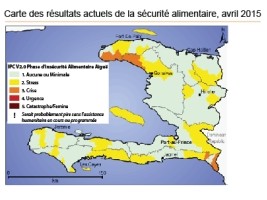|
||||||||||||||||||
|
|
Haiti - Agriculture : Food crisis risk in 4 departments 01/06/2015 11:07:46
Several communes of the country, like Anse-Rouge, the upper Artibonite, Bombardopolis, Anse-à-Galets face a dry period for more than 6 months, while the spring campaign represents 60% of the annual production of the country. Given the lack of water supply for large irrigation of crops, rainfall remains the determining factor. Moreover, lack of labor and its high cost remains a problem for farmers and could affect the amount of land planted and the volume of production at the end of cycle. Recall that the low production of 2014 has had an impact on seed prices and poorer farmers are forced to spend more to access it. Moreover, for some species such as sweet potato, yams and cassava cuttings are difficult to obtain. This could compromise the level of food security of the populations of these areas where these crops are simultaneously sources of food and income. In the rice-growing areas such as the Artibonite Valley, the Plain of Cayes and Saint Raphael, chemical fertilizers are available in very small quantities. Of the 20,000 to 30,000 metric tons generally available, only 8,000 are expected this year. At the same time, irrigation infrastructures deserve to be maintained in spite of the availability of water. The number of tractors, already inadequate, is now reduced to only 12 for the whole region of the Artibonite Valley. Harvest estimates made by the CNSA and its partners have shown greater than or equal yield declines to 50% depending on the crop that will cause a significant imbalance in terms of supply and demand for locally produced food. This will also result in the rise of prices of the food basket. This situation is not conducive to improving food security conditions. Very strong monitoring of the situation is needed in the bottom Northwest and some Southeast cities where the situation of the poor is inadequate. Despite the low number of humanitarian organizations on the ground, some projects are still ongoing and will help mitigate potential impacts and help the most disadvantaged people to hold on. Today, the projets AVANSE and PTTA in the North and the Northeast are still in the implementation phase. WFP continues to provide a hot meal to more than 400,000 students in public schools in the Far North, Artibonite, Centre and West. The transition appeal, launched in March, last address of residual humanitarian needs such as those related to cholera, IDPs and food security in a context where food security programs implemented by the government stopped since 2014. HL/ HaitiLibre
|
|
|
Why HaitiLibre ? |
Contact us |
Français
Copyright © 2010 - 2024 Haitilibre.com |



